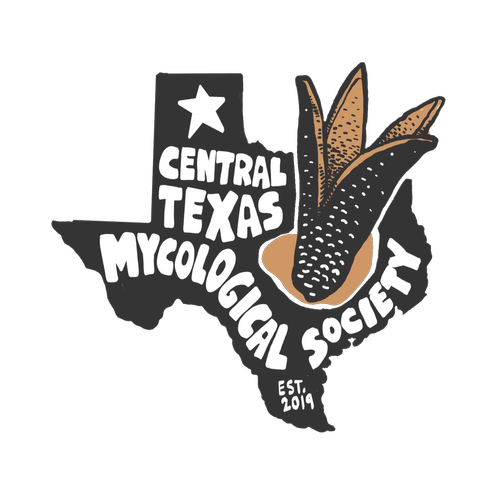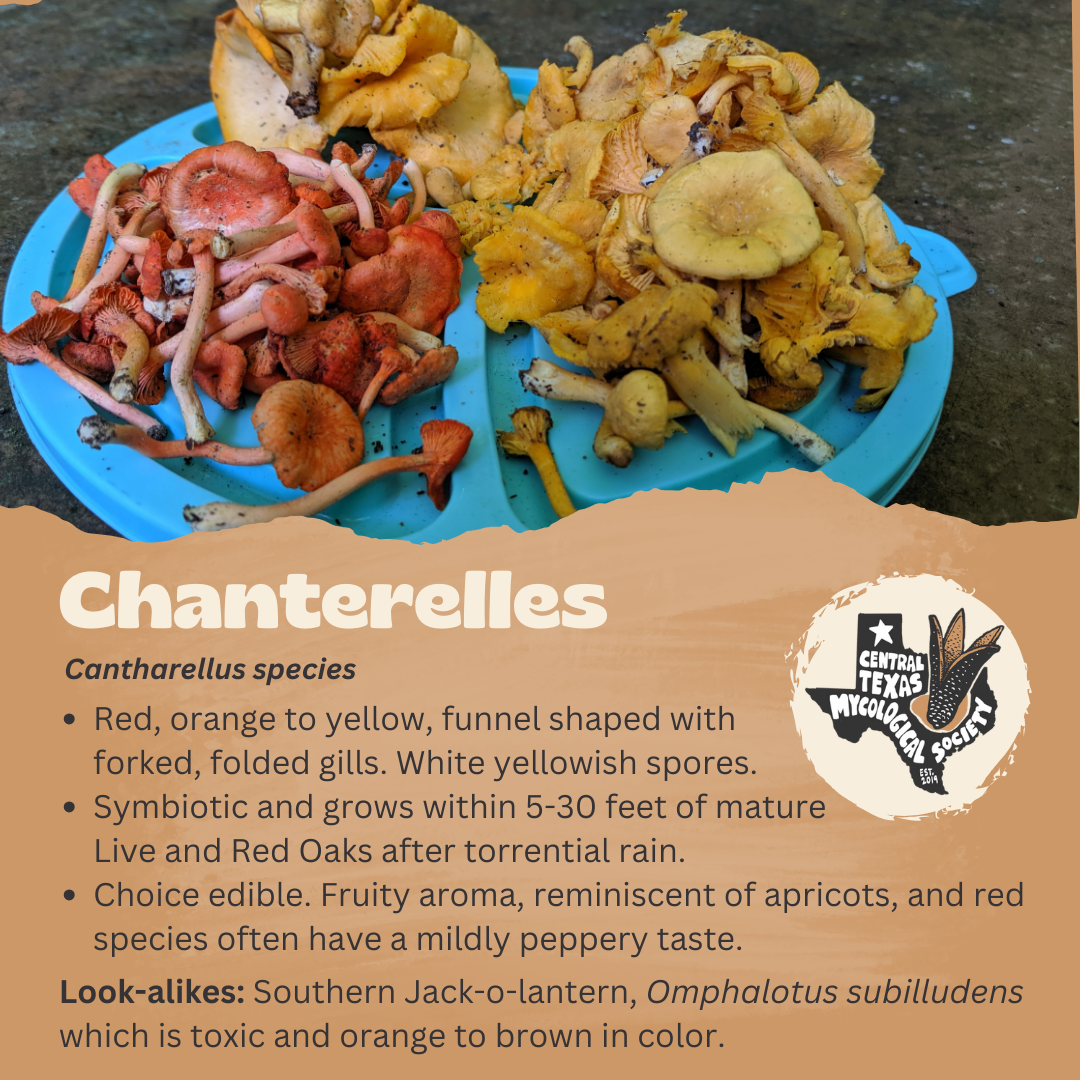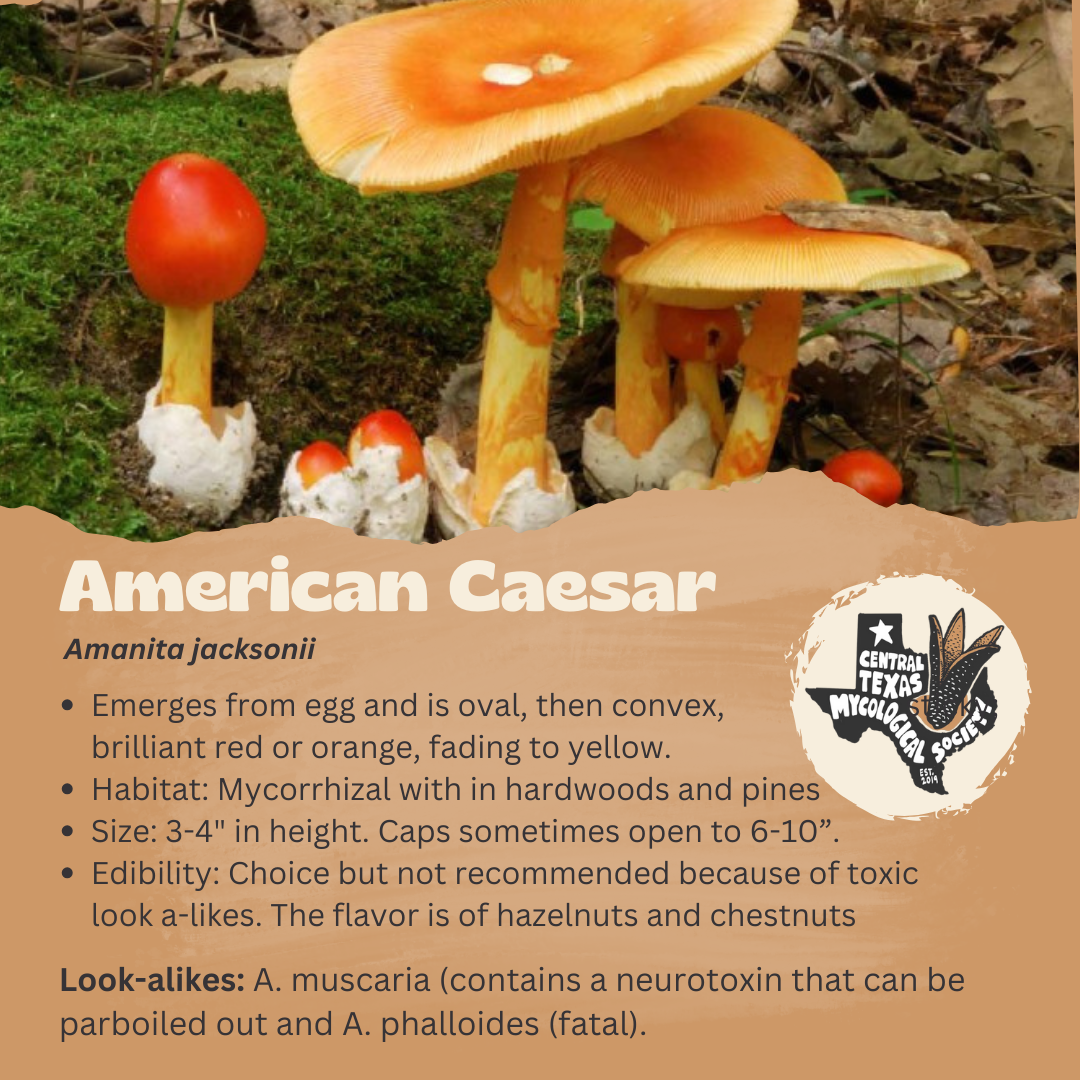Learn wild, edible mushrooms fruiting in Texas after rain.
Comes with download of a Wild Edible Mushroom Calendar.
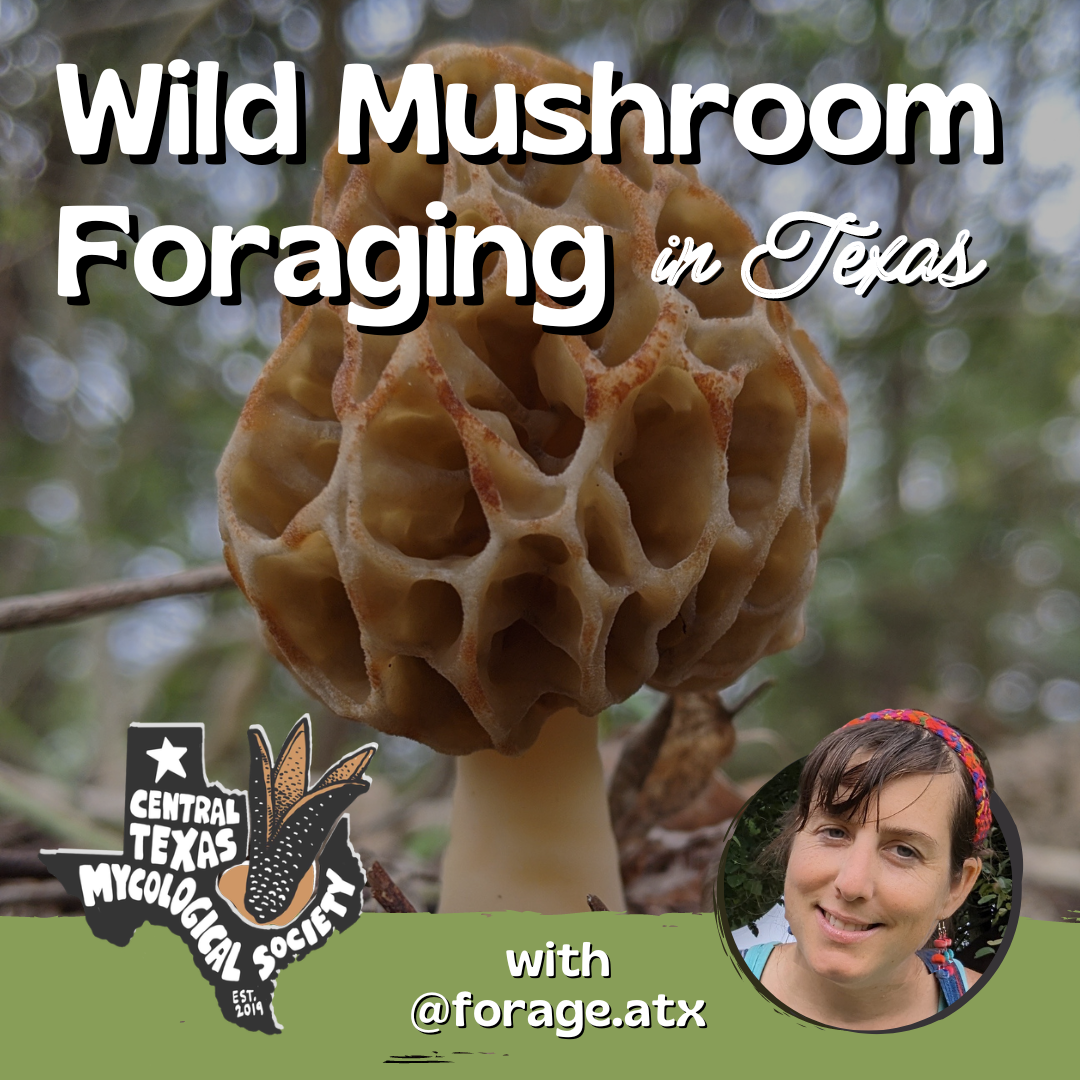
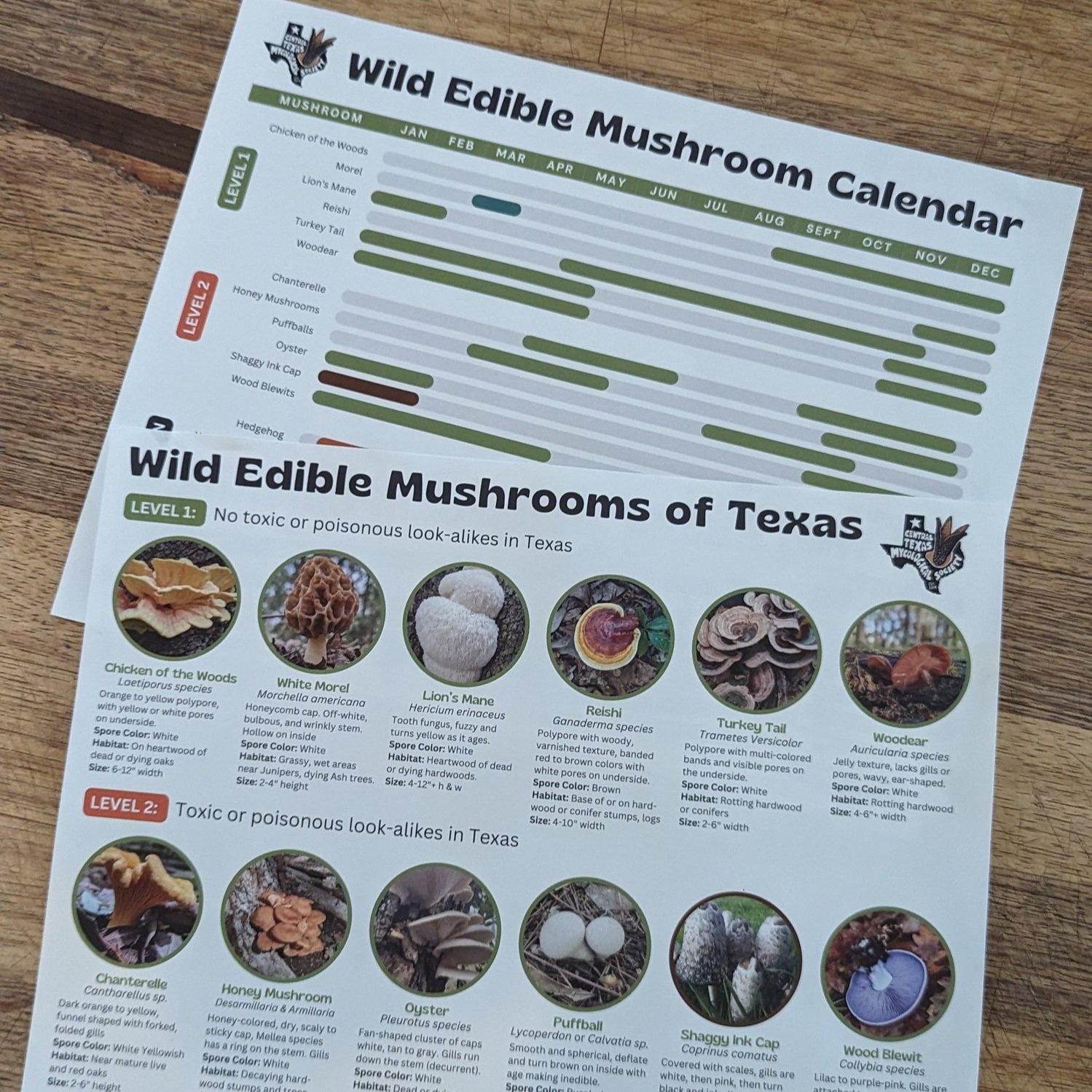
Blue Milkcap Lactarius Indigo
Blue cap with concentric rings and a central depression, 2.0–5.9", sticky or slimy to the touch.
In the Russulaceae family, with brittle flesh, stem.
Gills and body exude blue latex when injured tissue is and stains the wounded tissue greenish
Mycorrhizal and grows in mixed woods. Yellowish spores
Choice edible, peppery taste and has a coarse, grainy texture
Look-alikes: Blewit, Collybia nuda or Lactarius paradoxus (edible)
CHANTERELLE Cantharellus
DESCRIPTION: Red, orange, yellow to white, meaty and funnel-shaped and can be found in clusters or individual mushrooms. On the lower surface, underneath the smooth cap, most species have rounded, forked folds that run almost all the way down the stipe, which tapers down seamlessly from the cap.
SPORE COLOR: White Yellowish
HABITAT: Symbiotic and found around 5-30 feet of mature live and red oaks after a lot of rain. Chanterelles need a lot of rain to fruit and they like the torrential Texas-style flash floods. Trees near creeks and where water is flowing downhill is very important. Avoid trees that are in areas that are mowed. Trees with undisturbed leaf matter and not many understory plants are ideal.
SIZE: 2-6" height
EDIBILITY: Choice. Many species emit a fruity aroma, reminiscent of apricots, and often have a mildly peppery taste.
LOOK A-LIKE: The Southern Jack-o-lantern, Omphalotus subilludens is the toxic look-a-like and is orange to brown in color. They do grow at the same time but their habitat and morphology is different.
Lobster mushroom, Hypomyces lactifluorum
Parasitic fungus that grows on certain species of mushrooms, turning them a reddish orange color that resembles the outer shell of a cooked lobster.
Grows in mixed woods where H. lactifluorum specifically attacks members of the genera Lactarius and Lactifluus (milk-caps), and Russula (brittlegills), such as Russula brevipes and Lactifluus piperatus in North America. At maturity, H. lactifluorum thoroughly covers its host, rendering it unidentifiable.
White spore print
Edible with a subtle shellfish flavor that's easy to identify with no look alikes.
I spotted the Lobster shown in the photo on July 4, 2019 after we had consistent rain. Hypomyces may be parasitizing these mushrooms. Several members of the community have already seen them this year!
LOOK A-LIKE: The Southern Jack-o-lantern, Omphalotus subilludens is the toxic look-a-like and is orange to brown in color. They do grow at the same time but their habitat and morphology is different.
OLD-MAN-OF-THE-WOODS Strobilomyces strobilaceus
Cap is soft dark grey to black with overlapping scales of dark fuzz with an ascending annulus. The narrow stem also fuzzy and can with one or two ring zones.
In Boletaceae family with dirty white, hexagonal pores that turn reddish to black when bruised.
Usually growing single, on the ground in mixed hardwood forests and mycorrhizal with oaks.
Not a choice edible but young mushroom has a mellow, earthy flavor. Must be cooked.
Look-alikes: Strobilomyces confusus (non-toxic) or Amanita onusta (Toxicity unknown)
HONEY MUSHROOMS
Desarmillaria, Armillaria species
Honey-colored, dry, scaly to sticky cap, Mellea species has a ring on the stem. Grows in clusters and has gills. Part of a genus that is the largest living organism ever found on this planet.
SPORE COLOR: White
HABITAT: Decaying hard-wood stumps and roots of living trees in the spring and fall after rain.
SIZE: 6"
EDIBILITY: Choice. Many species emit a fruity aroma, reminiscent of apricots, and often have a mildly peppery taste.
LOOK A-LIKE: The Southern Jack-o-lantern, Omphalotus subilludens is the toxic look-a-like and is orange to brown in color. They do grow at the same time but their habitat and morphology is different.
Jackson's Slender Caesar
CAP: Emerges from egg or volva and is oval at first, becoming convex, typically with a central bump; sticky; brilliant red or orange, fading to yellow on the margin; typically without warts or patches; the margin lined for about 40–50% of the cap's radius. The red pigment fades from margin toward the center with age.
GILLS: Moderately crowded to crowded, orange-yellow to yellow-orange to yellow. They are free from the stem or slightly attached to it; yellow to orange-yellow; crowded; not bruising. The short gills are subtruncate to truncate.
STEM: 9-15 cm long; 1-1.5 cm thick; slightly tapering to apex; yellow; with orange to reddish fibers, often in zones; not bruising; with a yellow to orange, skirtlike ring; with a large (4-7 cm high and 4 mm thick), white, sacklike volva.
SPORE COLOR: White
HABITAT: Mycorrhizal with in hardwoods and pines. They are more common in East Texas but they can be found in Central Texas in places like Bastrop
SIZE: 3-4" in height. Caps sometimes open to 6-10”.
EDIBILITY: Choice but not recommended because of toxic look a-likes. The flavor is of hazelnuts and chestnuts.
LOOK A-LIKE: A. muscaria (contains a neurotoxin that can be parboiled out and A. phalloides (fatal).
honeycomb fungus
Genus of tropical fungi in the family Polyporaceae but with fleshy with radially arranged pores on the underside of the cap that are angular and deeply pitted, somewhat resembling a honeycomb. White to yellow and grows alone or in overlapping clusters similar to oyster mushrooms or other shelf fungi.
SPORE COLOR: White
HABITAT: On decaying hard-wood, year round when humidity is high after rain.
EDIBILITY: Odor slightly foul, especially in rehydrated material; taste not distinctive. Tough texture and can be cooked like chicharrones.
LOOK A-LIKE: Oysters, Pluerotus or Lentinellus cochleatus (none observed in Texas) but grow on decomposing wood.
Shoehorn Oyster Mushrooms
Hohenbuehelia petaloides
Pale to brown funnel-shaped caps with decurrent gills
SPORES: White
HABITAT: Fruits after rain in mulch or woody debris. Considered carnivorous because it traps nematodes with “sticky knobs” in the mycelium to obtain nitrogen and grow.
EDIBILITY: Edible when cooked but can be tough and mealy
Shoehorn Oyster Mushrooms, Hohenbuehelia petaloides is distinctively shaped; its "petaloid" habit often makes it look like a shoehorn with gills, or a rolled-up funnel. Other identifying features include its fairly crowded whitish gills, a white spore print, mealy odor and taste—and, under the microscope, gorgeous "metuloids" (thick-walled pleurocystidia). It often appears in clusters in urban, semi-urban, or even household settings, and is frequently associated with woody debris (though it does not usually grow directly from dead wood) or cultivated soil. However, it can be found in woodland settings, too, where it tends to grow alone or in small groups.
Because this mushroom grows in wood chips which are a good source of carbon but a terrible source of nitrogen, the fungi needs to make proteins. Both Hohenbuehelia and Pleurotus can supplement their protein needs by trapping and consuming nematodes, which are small flat worms that are very abundant in wood and soil. The fungi have "sticky knobs" on the hyphae that grow through the wood. These sticky knobs attach to curious nematodes as the nematodes attempt to eat the mycelium. The nematode thrashes around and additional parts of its body become stuck. The hyphae then grow into the body of the nematode and digest it, providing the fungus with the nitrogen it needs. That makes these fungi carnivorous!
LOOK A-LIKES: Oysters, Pluerotus or Lentinellus cochleatus (none observed in Texas) but grow on decomposing wood.
WOOD BLEWIT Collybia species, formerly Lepista, Clitocybe
Distinct lilac to purple-pink color
Grows in and decomposes leaf duff
Light pink to white spores
Great in breakfast tacos
As the weather stays cool, look out for the edible Wood Blewit, Collybia nuda or tarda species (formerly Lepista and Clitocybe.) This distinct lavender-colored mushroom is found from fall through spring and fruiting in hardwood leaf duff which is decomposes. Fresh wood blewits are great with eggs in breakfast tacos. As they get older they become more tan and iridescent colored on the cap and taste bitter. I throw the older wood blewits my compost leaf pile because they are such great decomposers and will colonize and grow in hardwood leaf litter.
Look-alikes: Be warned because there are deadly, poisonous look-alikes in the Cortinarius or webcap family that grow in similar conditions. It's important to do a spore print AND also confirm the ID with an expert. The spores of the wood blewit are light pink to white and the spores of Cortinarius mushrooms are rust colored. See our blog post with lots of photos and details to help you identify this mushroom.
OYSTER Pleurotus ostreatus
Color can vary white, tan and gray
White to cream gills, run down stem
Cap fan shaped, 2"-8" across, white spores
Grows in clusters and decomposes hardwood
Delicious meat replacement in all types of cuisines
Look-alikes: Southern Jack-o-lantern, Omphalotus subilludens which is toxic and orange to brown in color.
WOOD EAR: Auricularia species
Grows in clusters on decaying hardwood after rain
Cap is wavy, ear-shaped to irregular, 1-4" and > 1/4" thick
Jelly texture and lacks gills or pores
Produces white spores
Absorbs flavors, great in soups, contains protein, iron, calcium and phosphorus
Edibility: Wood ear mushrooms are a popular ingredient in many Chinese dishes, such as hot and sour soup, and also used in Chinese medicine. It is also used in Ghana, as a blood tonic. Modern research into possible medical applications has variously concluded that wood ear has anti-tumor, hypoglycemic, anticoagulant and cholesterol-lowering properties.
Look-alikes: Amber Jelly, Exidia recisa which is also edible.
Become a member and learn more about wild mushroom foraging in Texas!
Membership benefits include early access and discounts to walks, workshops, and more. Your membership helps support the larger community! Tag us to get help with ID and add your observations to iNaturalist.org. If you are trying a new mushroom, confirm the ID with an expert, then try a small amount to make sure you don't have an allergic reaction. Texas Mushroom Identification Facebook group is great for quick responses and ID help. Also, don't forget to add your finds on the Mushrooms of Texas project on iNaturalist.
